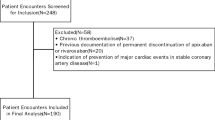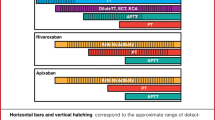Abstract
The purpose of this study is to determine the percentage of patients in the Johns Hopkins Anticoagulation Clinics that are potential candidates for the new oral anticoagulants, dabigatran, rivaroxaban, and apixaban. A retrospective chart review was conducted of patients managed in the Johns Hopkins Cardiology and Hematology Anticoagulation Clinics between November 1, 2009 and October 31, 2010. Data elements collected include demographics, primary indication for anticoagulation, renal function, hepatic function, and concomitant medications. These factors were considered against product labeling guidelines and inclusion/exclusion criteria from clinical studies to derive candidacy status for each oral anticoagulant for each patient. Patients who met at least one caution or contraindication criteria were deemed “non-candidates”; potential dosage reductions of the new oral anticoagulants were not considered. Four hundred ninety-one patients participated in the study. Among participants, 63 % would be dabigatran candidates, 62 % rivaroxaban candidates, and 70 % would be candidates for apixaban. Dabigatran use would be cautioned against in 34 %, rivaroxaban in 18 %, and apixaban in 30 %. Four percent had contraindications to dabigatran, whereas 21 % had contraindications to rivaroxaban. More than 60 % of patients in the Johns Hopkins Anticoagulation Clinics appear to be potential candidates for each of the new oral anticoagulants, assuming they are eventually approved for the same indications as warfarin. Many patients fell into the “cautioned” category, which demonstrates the complexity associated with selecting candidates for these new agents.
Similar content being viewed by others
References
Kanagasabapathy P, Chowdary P, Gatt A (2010) Alternatives to warfarin—the next generation of anticoagulants. Cardiovasc Ther 00:1–9
Boehringer Ingelheim Pharmaceuticals (2010) Pradaxa (dabigatran) package insert, Boehringer Ingelheim Pharmaceuticals, Ridgefield, CT, USA
Jassen Pharmaceuticals (2011) Xarelto (rivaroxaban) package insert, Jassen Pharmaceuticals, Titusville, NJ, USA
Connolly SJ, Ezekowitz MD, Yusuf S et al (2009) Dabigatran versus warfarin in patients with atrial fibrillation. N Engl J Med 361:1139–1151
Patel MR, Mahaffey KW, Garg J et al (2011) Rivaroxaban versus warfarin in nonvalvular atrial fibrilliation. N Engl J Med 365:883–891
Turpie AG, Lassen MR, Kakkar AK, et al (2008) A meta-analysis of three pivotal studies of rivaroxaban—a novel, oral, direct factor XA inhibitor—for thromboprophylaxis after orthopaedic surgery. International Congress on Thrombosis, Abstract O56, Athens, Greece, 27 June 2008
Husten L (2011) Apixaban gains priority FDA review for stroke and VTE prevention in AF. Forbes. http://www.forbes.com/sites/larryhusten/2011/11/29/apixaban-gains-priority-fda-review-for-stroke-and-vte-prevention-in-af/. Accessed 21 Jan 2012
Walenga JM, Adiguzel C (2010) Drug and dietary interaction of the new and emerging oral anticoagulants. Int J Clin Pract 64(7):956–967
Schulman SS, Kearon C, Kakkar AK et al (2009) Dabigatran versus warfarin in the treatment of acute venous thromboembolism. N Engl J Med 361:2342–2352
Paikin JS, Eikelboom JW, Cairns JA, Hirsh J (2010) New antithrombotic agents—insights from clinical trials. Nat Rev Cardiol 7:498–509
Boehringer Ingelheim Pharmaceuticals (2000) A randomised, phase II study to evaluate the safety and pharmacokinetics of oral dabigatran etexilate in patients after heart valve replacement. In: ClinicalTrials.gov [Internet]. National Library of Medicine (US) [cited 2012 Apr 25], Bethesda. http://www.clinicaltrials.gov/ct2/show/NCT01452347?term=cardiac+valve+AND+dabigatran&rank=1 NLM Identifier: NCT01452347
Bayer Schering Pharma AG (2009) Xarelto (rivaroxaban) package insert, Bayer Schering Pharma AG, Berlin, Germany
Boehringer Ingelheim GmbH (2009) Pradaxa (dabigatran) package insert, Boehringer Ingelheim GmbH, Dortmund, Germany
Granger CB, Alexander JH, McMurray JJ et al (2011) Apixaban versus warfarin in patients with atrial fibrillation. N Engl J Med 365:981–992
Connolly SJ, Eikelboom J, Joyner C et al (2011) Apixaban in patients with atrial fibrillation. N Engl J Med 364:806–817
Lassen MR, Gallus A, Raskob GE, Pineo G, Chen D, Ramirez LM (2010) Apixaban versus enoxaparin for thromboprophylaxis after hip replacement. N Engl J Med 363:2487–2498
Harper P, Young L, Merriman E (2012) Bleeding risk with dabigatran in the frail elderly. N Engl J Med 366:864–866
Verheugt FW (2010) The new oral anticoagulants. Neth Heart J 18:314–318
Roser-Jones C, Becker RC (2010) Apixaban: an emerging oral factor Xa inhibitor. J Thromb Thromblysis 29:141–146
Goldhaber S, Leizorovicz A, Kakkar AK et al (2011) Apixaban versus enoxaparin for thromboprophylaxis in medically ill patients. N Engl J Med 365:2167–2177
Conflict of interest
The authors declare that they have no conflicts of interest to disclose.
Author information
Authors and Affiliations
Corresponding author
Additional information
Kimberly L. Carter—Previously the PGY2 ambulatory care specialty pharmacy resident at The Johns Hopkins Hospital for the 2010–2011 year.
Electronic supplementary material
Below is the link to the electronic supplementary material.
Rights and permissions
About this article
Cite this article
Carter, K.L., Streiff, M.B., Ross, P.A. et al. Analysis of the projected utility of dabigatran, rivaroxaban, and apixaban and their future impact on existing Hematology and Cardiology Anticoagulation Clinics at The Johns Hopkins Hospital. J Thromb Thrombolysis 34, 437–445 (2012). https://doi.org/10.1007/s11239-012-0781-z
Published:
Issue Date:
DOI: https://doi.org/10.1007/s11239-012-0781-z




